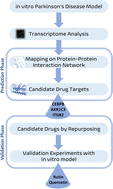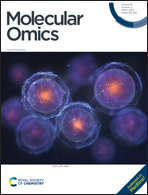A transcriptome based approach to predict candidate drug targets and drugs for Parkinson's disease using an in vitro 6-OHDA model†
Abstract
The most common treatment strategies for Parkinson's disease (PD) aim to slow down the neurodegeneration process or control the symptoms. In this study, using an in vitro PD model we carried out a transcriptome-based drug target prediction strategy. We identified novel drug target candidates by mapping genes upregulated in 6-OHDA-treated cells on a human protein–protein interaction network. Among the predicted targets, we show that AKR1C3 and CEBPB are promising in validating our bioinformatics approach since their known ligands, rutin and quercetin, respectively, act as neuroprotective drugs that effectively decrease cell death, and restore the expression profiles of key genes upregulated in 6-OHDA-treated cells. We also show that these two genes upregulated in our in vitro PD model are downregulated to basal levels upon drug administration. As a further validation of our methodology, we further confirm that the potential target genes identified with our bioinformatics approach are also upregulated in post-mortem transcriptome samples of PD patients from the literature. Therefore, we propose that this methodology predicts novel drug targets AKR1C3 and CEBPB, which are relevant to future clinical applications as potential drug repurposing targets for PD. Our systems-based computational approach to predict candidate drug targets can be employed in identifying novel drug targets in other diseases without a priori assumption.



 Please wait while we load your content...
Please wait while we load your content...